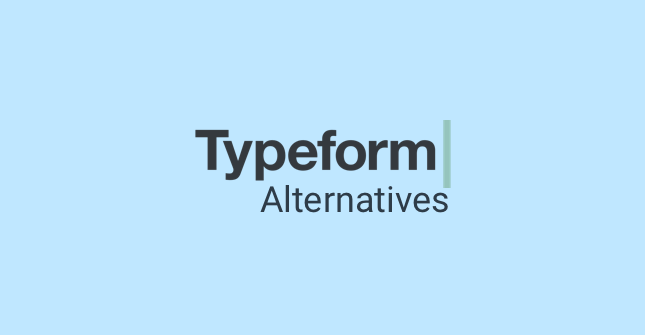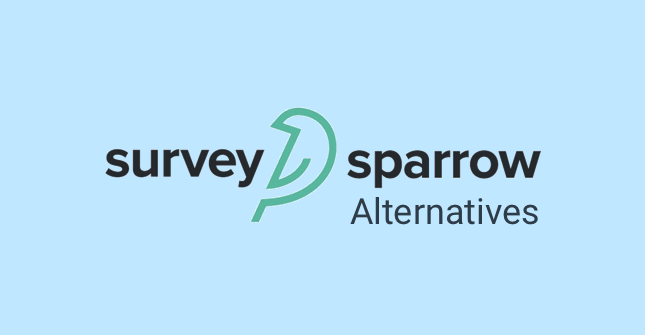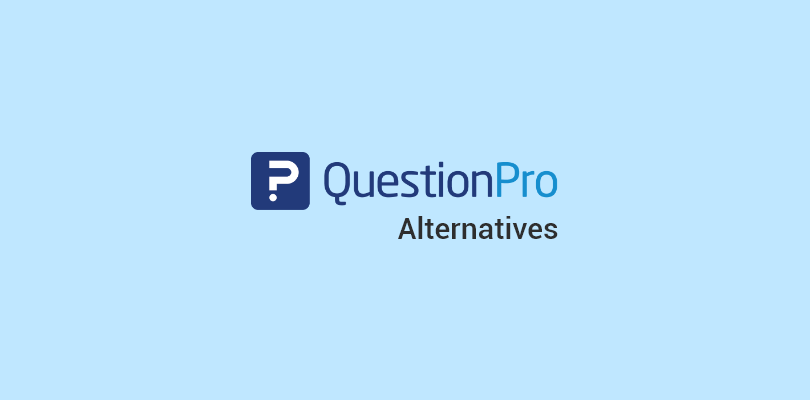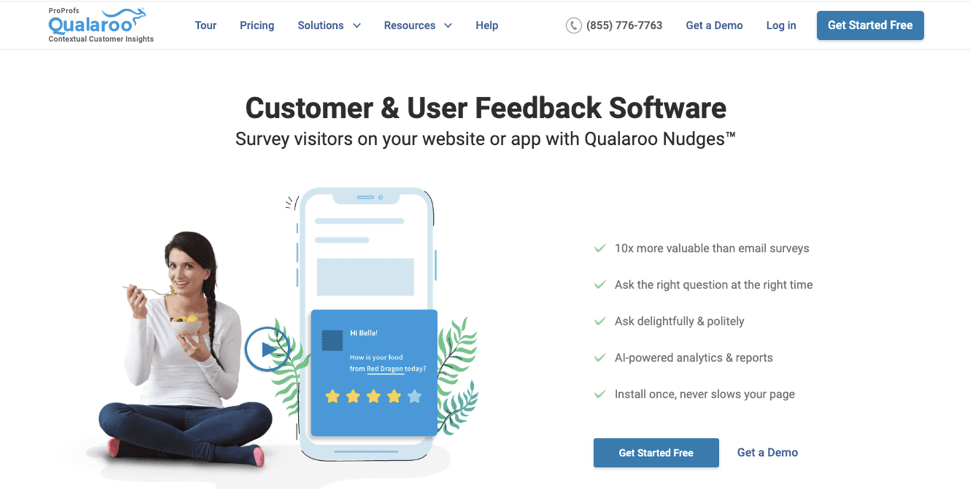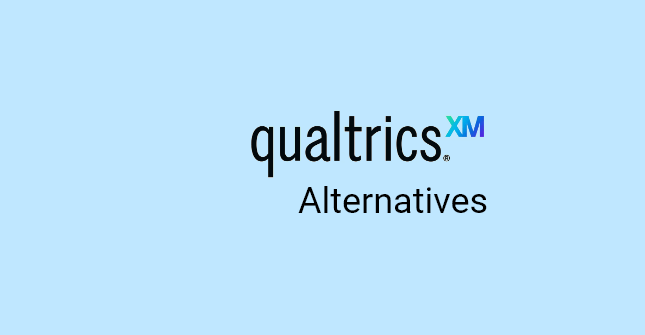You start with WebEngage to keep things simple. Popups, surveys, and automation, one tool to rule them all. Then the cracks appear. The exit survey fires on the wrong page. The design looks nothing like your site. Support tells you to clear the cache. You laugh, then sigh.
Soon, you’re duct-taping fixes with a WebEngage alternative. What started as one clean system is now three dashboards and a weekly sync meeting.
WebEngage isn’t bad. It’s just not built for how fast modern teams move. You need sharper targeting, deeper integrations, and designs that don’t look like 2014.
If that sounds familiar, this list is for you: 10 WebEngage competitors & alternatives that actually fix the problems instead of adding new ones. Let’s cover the basics first and begin by understanding why teams eventually outgrow WebEngage!
Why You’re Probably Looking for a WebEngage Alternative
WebEngage does the job until your workflow starts to get serious. Then it slows you down in all the ways that matter, like precision, control, and consistency. If you’re already feeling that drag, here’s why most teams start shopping for an alternative.
- Targeting feels blunt when you need precision. You can’t easily run behavior-based targeting or show surveys to users on specific URLs or flows without looping in a developer. The result? You either target too broadly or miss the exact audience that matters.
- Design and customization hit a wall. Popups and surveys often feel like they were built in a different decade. You can tweak colors and text, but matching your brand’s tone or UI polish takes time and CSS hacks — and it still never looks native.
- Too many tools, not enough alignment. WebEngage covers engagement, but not feedback or analytics deeply enough. So teams end up pairing it with SurveyMonkey for responses and Delighted for NPS — three dashboards, three logins, and one messy feedback loop.
- Integrations don’t go deep enough. WebEngage connects with popular CRMs and analytics tools, but the data syncing is shallow. Real-time insights get lost, and you end up exporting CSVs to keep your systems aligned.
- Support and iteration speed are slow. Updates roll out inconsistently, and smaller teams often wait longer for fixes or feature requests. You spend more time working around limitations than building new campaigns.
- Scaling exposes the cracks. The more complex your user journeys get, the slower WebEngage feels. It’s solid for mid-stage automation but struggles with high-velocity engagement where data needs to move in real time.
Most teams don’t quit WebEngage in frustration; they simply outgrow it. They reach a point where patching things up costs more time than switching tools entirely.
If that’s where you are, the rest of this list is for you: the tools that actually fix what WebEngage left unfinished.
Quick Comparison of WebEngage Alternatives
If you only have ten minutes between investor calls or sprint reviews, this table gives you the quick read: who’s best for what, what they nail, and where to start your trials.
Think of it as your shortlist before the deep dive.
| Tool | Best For | Key Strength | G2 Rating | Starting Price |
|---|---|---|---|---|
| Qualaroo | Contextual user feedback | Behavior-based surveys and AI sentiment analysis | 4.8 (Capterra) | A free plan is available. Paid starts from $19.99/month |
| Insider | AI-powered personalization | Predictive intent and omnichannel automation | 4.8 (G2) | Custom quote |
| CleverTap | Mobile-first engagement | Real-time streaming and segmentation | 4.6 (G2) | From $75/month |
| MoEngage | Fast setup and automation | Multi-channel orchestration, ease of use | 4.5 (G2) | Custom quote |
| Netcore Cloud | APAC-focused marketing cloud | Integrated messaging and automation | 4.4 (G2) | Custom quote |
| Braze | Enterprise-scale orchestration | Advanced journey management for big teams | 4.5 (G2) | Custom quote |
| OneSignal | Small teams and startups | Push notifications and in-app engagement | 4.7 (Capterra) | From $19/month |
| Brevo (formerly Sendinblue) | SMB marketing automation | Email and SMS campaigns | 4.5 (G2) | From $8/month |
| Omnisend | E-commerce brands | Prebuilt templates and omnichannel flows | 4.6 (G2) | From $11.20/month |
| Iterable | Data-driven growth teams | CDP plus cross-channel automation | 4.4 (G2) | Custom quote |
Detailed Breakdown: 10 WebEngage Alternatives That Actually Deliver
Tables are great for scanning, but the real story lives in how these tools behave in practice. Features and pricing tell you what they can do. The real question is what happens when you start using them: how clean the targeting feels, how well the integrations hold, and whether support actually shows up when things break.
This next section goes tool by tool. Let’s start with the one that replaces three of your current tools in one dashboard:
1. Qualaroo — In-Context Feedback That Gets to the Why
After using Qualaroo for almost a year now, I can finally say we are getting answers instead of guesses. It helps you understand why users act the way they do. Unlike tools built for automation or multichannel engagement, Qualaroo focuses purely on in-product and on-site feedback. It uses targeted “Nudges”: lightweight surveys that appear in context to capture opinions while users are actually experiencing your product. You can segment by behavior, time on page, or device, which makes the feedback far more actionable than post-session surveys.
Pros
- AI-powered sentiment analysis to interpret open-ended responses
- Advanced targeting for contextual, behavior-based surveys
- Intuitive interface and fast survey deployment
- Strong integrations with analytics and CRM tools
- Ideal for UX, product, and research teams
- Seamless integrations with tools like Mailchimp, HubSpot, and more.
Cons
- No dark mode for long creation sessions
- Fully cloud-based, so you need an internet connection to access projects
How Qualaroo Compares to WebEngage
While WebEngage manages surveys alongside automation, Qualaroo focuses entirely on in-the-moment insight. It captures user sentiment directly within your product flow — something most engagement platforms only approximate through after-the-fact surveys. If your goal is to understand user motivation rather than drive campaigns, Qualaroo delivers sharper, more immediate feedback.
Pricing: Starts at $19.99/month. A free plan is also available, offering all premium features for growing teams.
User Rating: 4.7 (Capterra)
2. Insider — Predictive Personalization That Scales Before You Do

A friend who runs growth at a fintech startup once told me, “Insider feels like it knows what my users want before I do.” He wasn’t exaggerating. Insider’s real edge is how it handles timing. It predicts what a user is likely to do next and fires the right message at the right moment across web, push, email, WhatsApp, and more. The setup takes effort, but once it’s running, it feels like a silent operator fine-tuning every touchpoint in real time.
Pros
- Predictive AI that identifies user intent before it happens
- Omnichannel orchestration across 12+ platforms
- Real-time data processing with zero lag between action and automation
- Advanced segmentation and personalization capabilities
- Reliable onboarding and support for enterprise teams
Cons
- Needs a solid data setup to show full value
- Pricing leans enterprise, so not ideal for smaller teams
How Insider Compares to WebEngage
WebEngage relies on static rules and past actions to drive campaigns, which means you’re always reacting. Insider uses predictive behavior modeling, so your messages hit before the user drifts away. The difference shows up in retention metrics and campaign ROI. If you’ve outgrown “send-after-click” automation and want real-time orchestration, Insider is what you move to next.
Pricing: Custom quote based on use case, volume, and channels.
User Rating: 4.8 (G2)
3. CleverTap — Real-Time Mobile Engagement That Doesn’t Miss a Beat
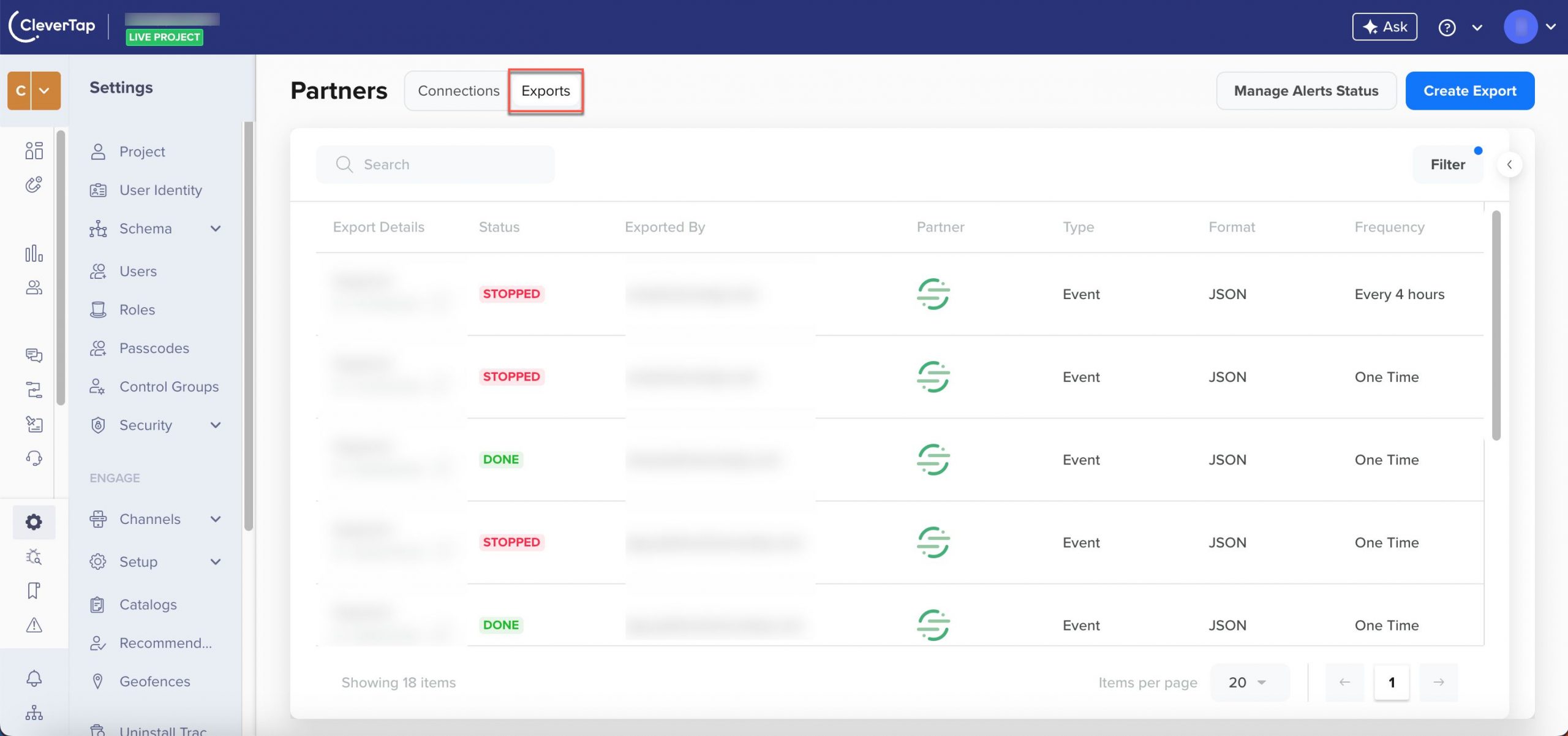
I first heard about CleverTap from a product manager at a food delivery app who swore it “never misses a user heartbeat.” She wasn’t being poetic; she meant data. CleverTap operates on a real-time streaming architecture, which enables you to segment and target users based on their current actions, rather than their past behavior. It’s a lifesaver for mobile-heavy products where timing is everything. WebEngage, by comparison, often feels like it’s still processing yesterday’s data.
Pros
- Real-time streaming for instant segmentation and personalization
- Mobile-first design that feels native to in-app journeys
- Advanced analytics for churn prediction and retention tracking
- Powerful push and in-app messaging workflows
- Integration with major attribution tools and CDPs
Cons
- Interface takes time to master
- Pricing can climb fast as active users scale
How CleverTap Compares to WebEngage
WebEngage stores engagement data in batches, which works fine for basic automation but falls short for real-time experiences. CleverTap’s streaming model makes it faster and more responsive, so you can act on behavior as it happens. If you’re running a product that depends on app sessions or daily activity, the difference isn’t small; it’s night and day.
Pricing: Starts at $75 per month, with pricing based on monthly active users and features.
User Rating: 4.6 (G2)
4. MoEngage — Fast, Friendly Automation for High-Velocity Teams
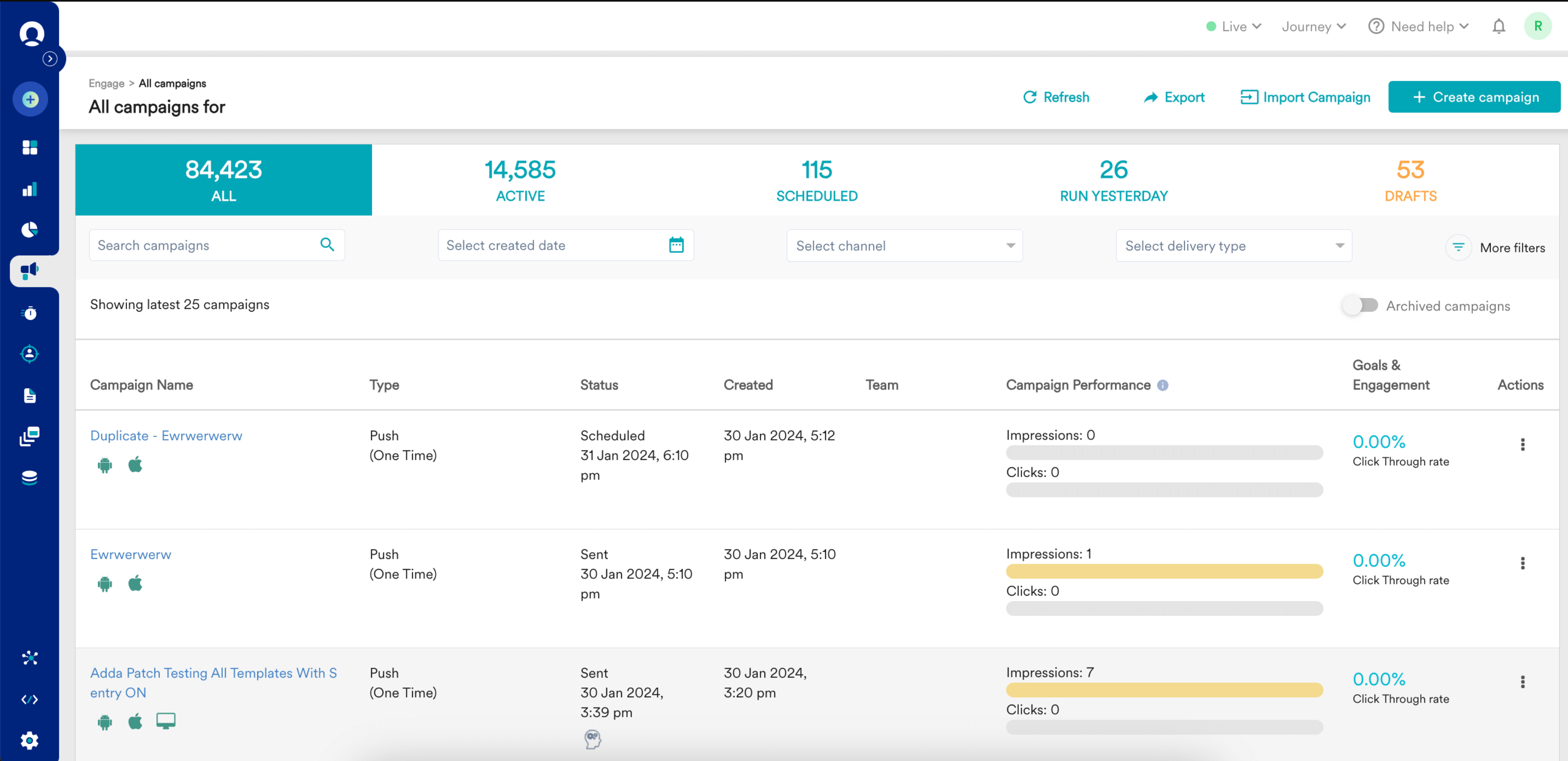
A growth lead at an edtech company once told me, “MoEngage feels like CleverTap’s more approachable cousin.” It’s true. The setup is quick, the learning curve is mild, and the automation builder is simple enough for non-technical teams to use right away. You won’t get the deep real-time horsepower of CleverTap, but you’ll get a system that moves fast and stays stable. It’s perfect for teams who care about getting multichannel campaigns live without weeks of engineering support.
Pros
- Smooth onboarding with fast time-to-value
- Multi-channel automation across email, SMS, push, and in-app
- Clean, intuitive campaign builder
- Strong segmentation and personalization options
- Stable performance and solid documentation
Cons
- Historical lookback for segmentation is limited
- Advanced analytics can get pricey
How MoEngage Compares to WebEngage
Both tools cover similar ground, but MoEngage executes better on simplicity and setup speed. You can spin up campaigns in hours instead of days. WebEngage often struggles with older campaign data and slow reporting, while MoEngage trades a bit of depth for much faster usability, which most teams are happy to take.
Pricing: Custom quote based on usage, data volume, and campaign scale.
User Rating: 4.5 (G2)
5. Netcore Cloud — The APAC Workhorse With Real Breadth
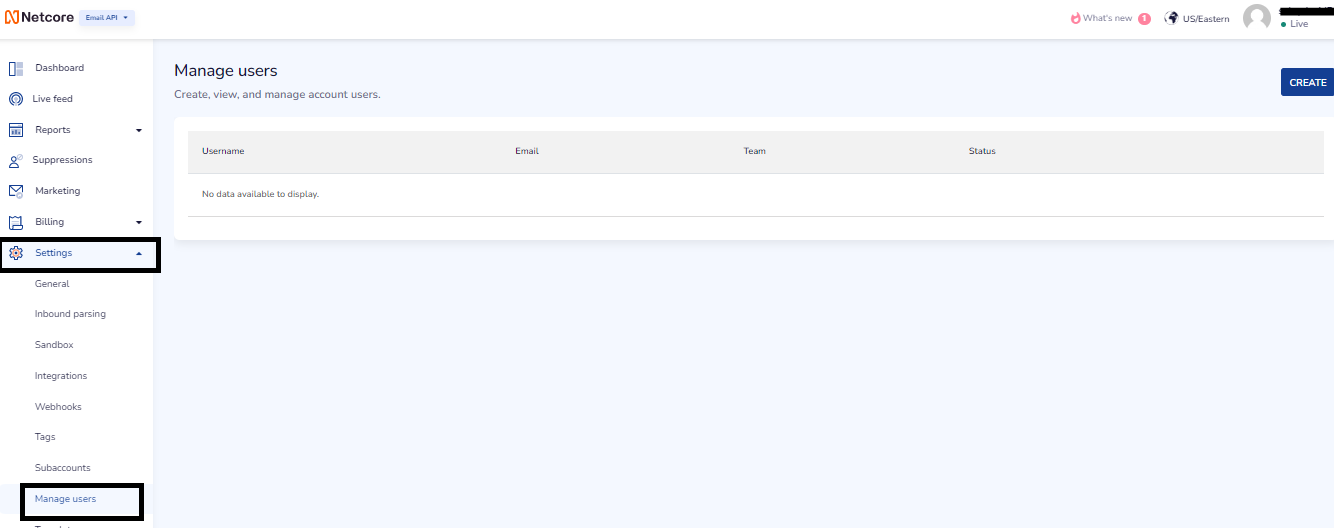
I heard about Netcore from a founder friend in Singapore who runs an e-commerce brand with customers across five countries. He called it “the most quietly reliable stack we’ve used.” That’s pretty accurate. Netcore doesn’t chase flash. It focuses on consistency and scale, especially across the Asia-Pacific region, where connectivity and compliance can vary by market. It’s a full-stack engagement platform, offering email, SMS, WhatsApp, web push, and analytics, all bundled neatly.
Pros
- Covers all major engagement channels in one platform
- Known for strong deliverability and reliable infrastructure
- Localization and compliance built for APAC markets
- AI-powered personalization and product recommendations
- Smooth campaign management for multi-market teams
Cons
- Interface feels a bit dated compared to newer tools
- Advanced automation requires setup support
How Netcore Cloud Compares to WebEngage
WebEngage can run multichannel campaigns, but Netcore scales them across regions more cleanly. It’s built for companies that care about consistency, where one failed WhatsApp push could mean lost conversions. It’s not as shiny as Insider or CleverTap, but it’s battle-tested and built for markets that WebEngage often struggles to localize for. If you operate in Asia or manage distributed teams, Netcore Cloud gives you dependable reach without the drama.
Pricing: Custom quote based on market coverage and feature set.
User Rating: 4.4 (G2)
6. Braze — Enterprise-Grade Orchestration Without the Chaos
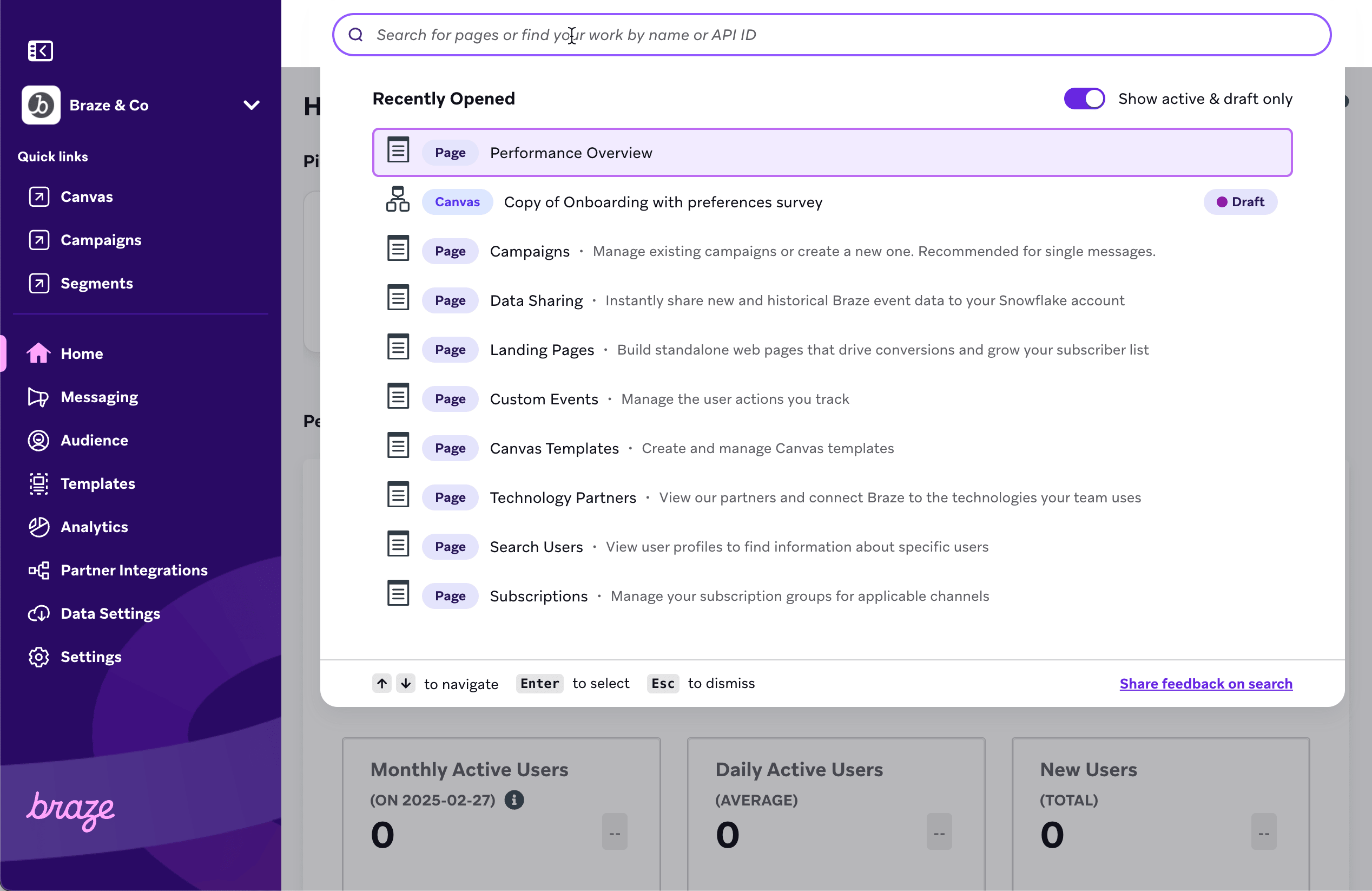
Every large team I’ve met that outgrew basic automation eventually mentions Braze. Usually with a mix of awe and mild fear. Braze runs complex, high-scale engagement across web, email, mobile, and in-app channels. You can build journeys that respond to user behavior across touchpoints, sync instantly with your data warehouse, and deliver hyper-personalized content at ridiculous scale. The catch is the learning curve. It’s not plug-and-play, and it’s priced for companies that can afford to think long term.
Pros
- Enterprise-grade customer journey builder
- Real-time personalization across multiple channels
- Deep integrations with CDPs and data warehouses
- Highly scalable infrastructure for global campaigns
- Excellent documentation and community resources
Cons
- Expensive and overkill for smaller teams
- Requires engineering help to unlock its full potential
How Braze Compares to WebEngage
WebEngage gives you automation. Braze gives you orchestration. Where WebEngage can automate a campaign, Braze can adapt it mid-flight based on real-time user behavior. It’s the difference between sending a campaign and running a living, evolving customer journey. If you’re at a stage where personalization drives millions in revenue, Braze is the tool you graduate to.
Pricing: Custom quote based on volume, channels, and enterprise needs.
User Rating: 4.5 (G2)
7. OneSignal — Simple, Reliable Engagement for Teams That Move Fast

A startup founder I know once said, “We didn’t choose OneSignal — we just never found a reason to replace it.” That’s the kind of product it is. OneSignal started as a push notification tool but quietly evolved into a full multichannel engagement platform. It’s built for speed. You can ship a campaign the same day you create your account. The analytics are clear, the triggers are simple, and the free plan is surprisingly generous. For smaller teams or fast-moving startups, it’s often the perfect “good enough” solution that stays good for years.
Pros
- Fast setup and intuitive interface
- Great for push notifications and in-app messages
- Multichannel support for email, SMS, and web push
- Clear analytics with delivery and engagement metrics
- Developer-friendly APIs for deeper customization
Cons
- Limited automation depth compared to enterprise tools
- Some advanced features are paywalled
How OneSignal Compares to WebEngage
WebEngage gives you depth, but at the cost of setup complexity. It’s not designed to replace complex customer journeys, but it nails the basics with reliability and polish. For smaller teams, that’s usually all you need. If you want something simple that won’t need an ops manual, OneSignal is the rare “fast and good” option that actually holds up.
Pricing: Starts at $19 per month, with a free plan available for smaller use cases.
User Rating: 4.7 (Capterra)
8. Brevo (formerly Sendinblue) — Affordable Automation That Just Works
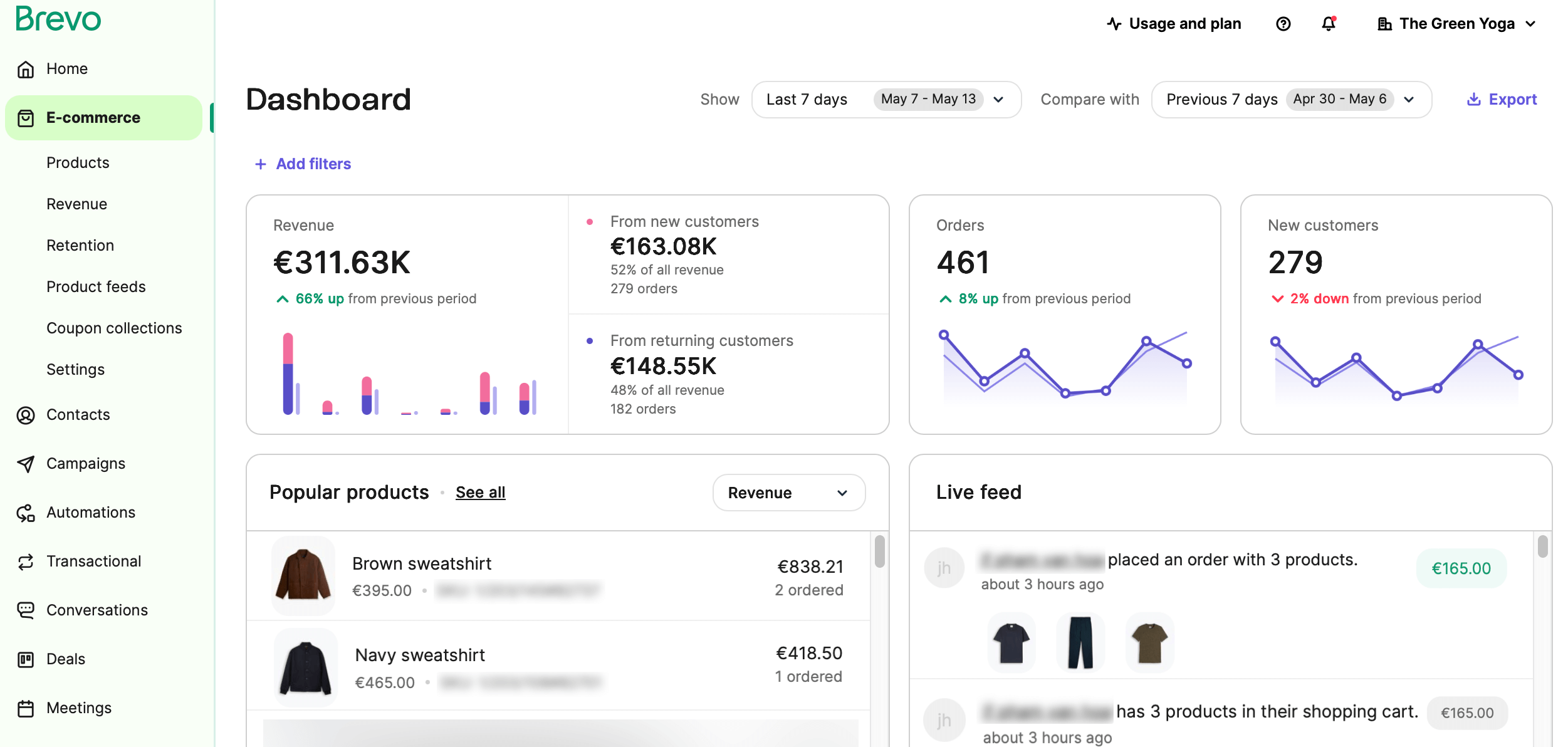
Brevo is the tool most teams find when they hit their first “we can’t keep doing this manually” moment. It started as an email marketing platform but has grown into a solid automation suite that includes SMS, chat, and CRM features. I’ve seen early-stage SaaS teams use it for onboarding emails, e-commerce brands run abandoned cart workflows, and agencies build client campaigns without a single line of code. It’s not fancy, but it’s dependable.
Pros
- Easy setup with minimal learning curve
- All-in-one platform covering email, SMS, chat, and CRM
- Affordable pricing with flexible tiers
- Clean UI that makes automation approachable
- Reliable deliverability and campaign tracking
Cons
- Limited advanced reporting features
- UI can lag with larger lists or heavy segmentation
How Brevo Compares to WebEngage
WebEngage aims to do everything; Brevo focuses on doing a few things really well — and cheaply.
For teams that just need dependable automation and multichannel reach without enterprise complexity, Brevo delivers faster value with far less setup pain. If your marketing stack needs to move fast on a budget, this one deserves a serious look.
Pricing: Starts at $8 per month, with higher tiers for automation and advanced CRM features.
User Rating: 4.5 (G2)
9. Omnisend — E-Commerce Engagement That Prints Money
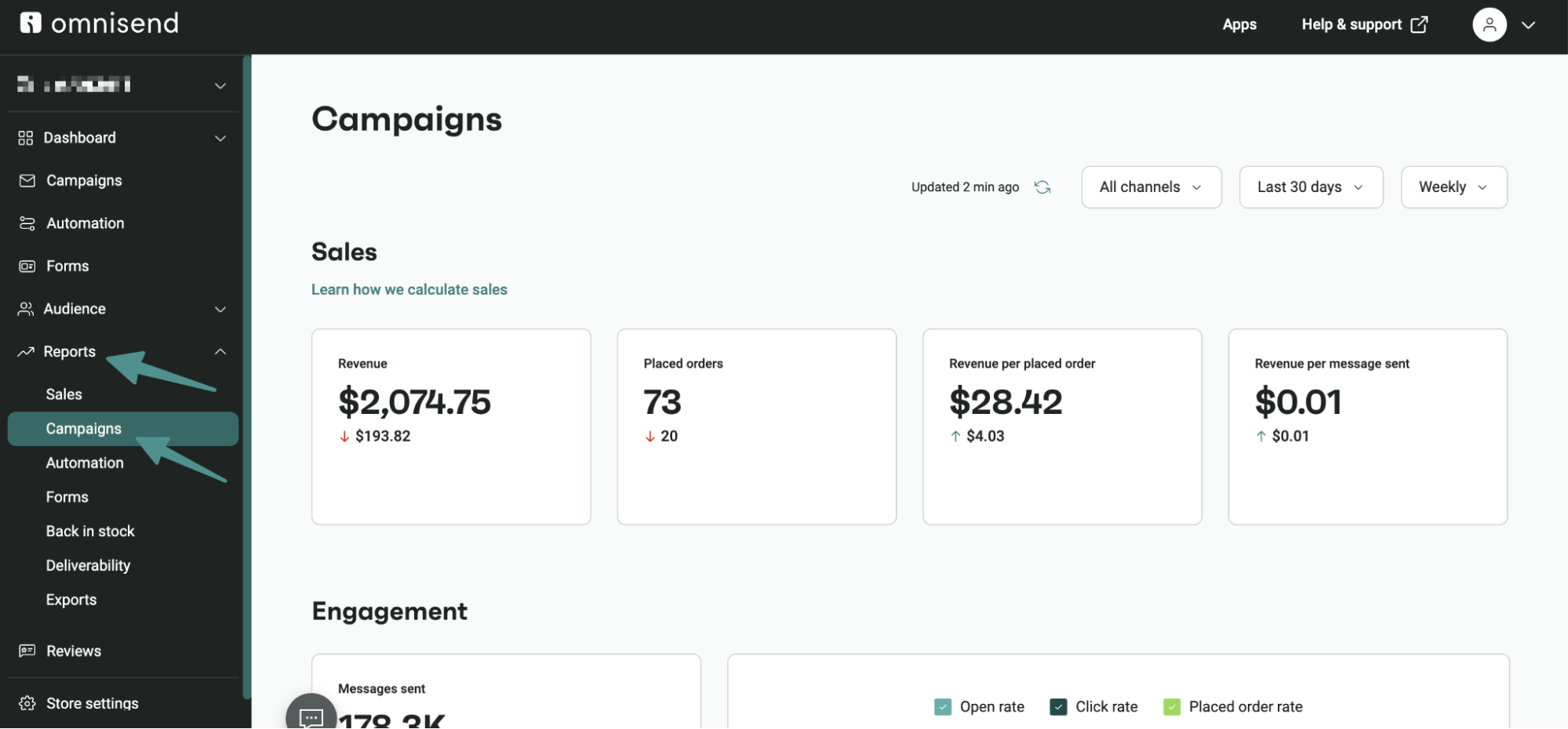
I first heard about Omnisend from an e-commerce founder who told me, “It paid for itself the week we turned it on.” Omnisend is built for stores that live and die by customer retention. It ties together email, SMS, and push into prebuilt workflows that you can launch almost instantly. You pick a goal, like recovering carts, welcoming new customers, re-engaging drop-offs, and Omnisend handles the logic.
The real strength is speed. You don’t need to think about templates or design; they’re already optimized for conversions. You just plug in your products, connect your store, and go live.
Pros
- Prebuilt automation templates that drive sales fast
- Unified workflows across email, SMS, and push
- Native integrations with Shopify, WooCommerce, and BigCommerce
- Clean analytics dashboard that tracks ROI by channel
- Affordable plans that scale with store size
Cons
- Best suited for e-commerce; not ideal for SaaS or service brands
- Limited advanced journey customization
How Omnisend Compares to WebEngage
WebEngage was built for engagement; Omnisend was built for conversion. Where WebEngage gives you targeting and messaging logic, Omnisend focuses on outcomes, turning abandoned carts into orders and first-time buyers into repeat customers. If your business runs on transactions and retention, Omnisend is the smarter, faster, more focused move.
Pricing: Starts at $11.20 per month, with scalable pricing for higher send volumes.
User Rating: 4.6 (G2)
10. Iterable — Data-Driven Automation for Growth Teams
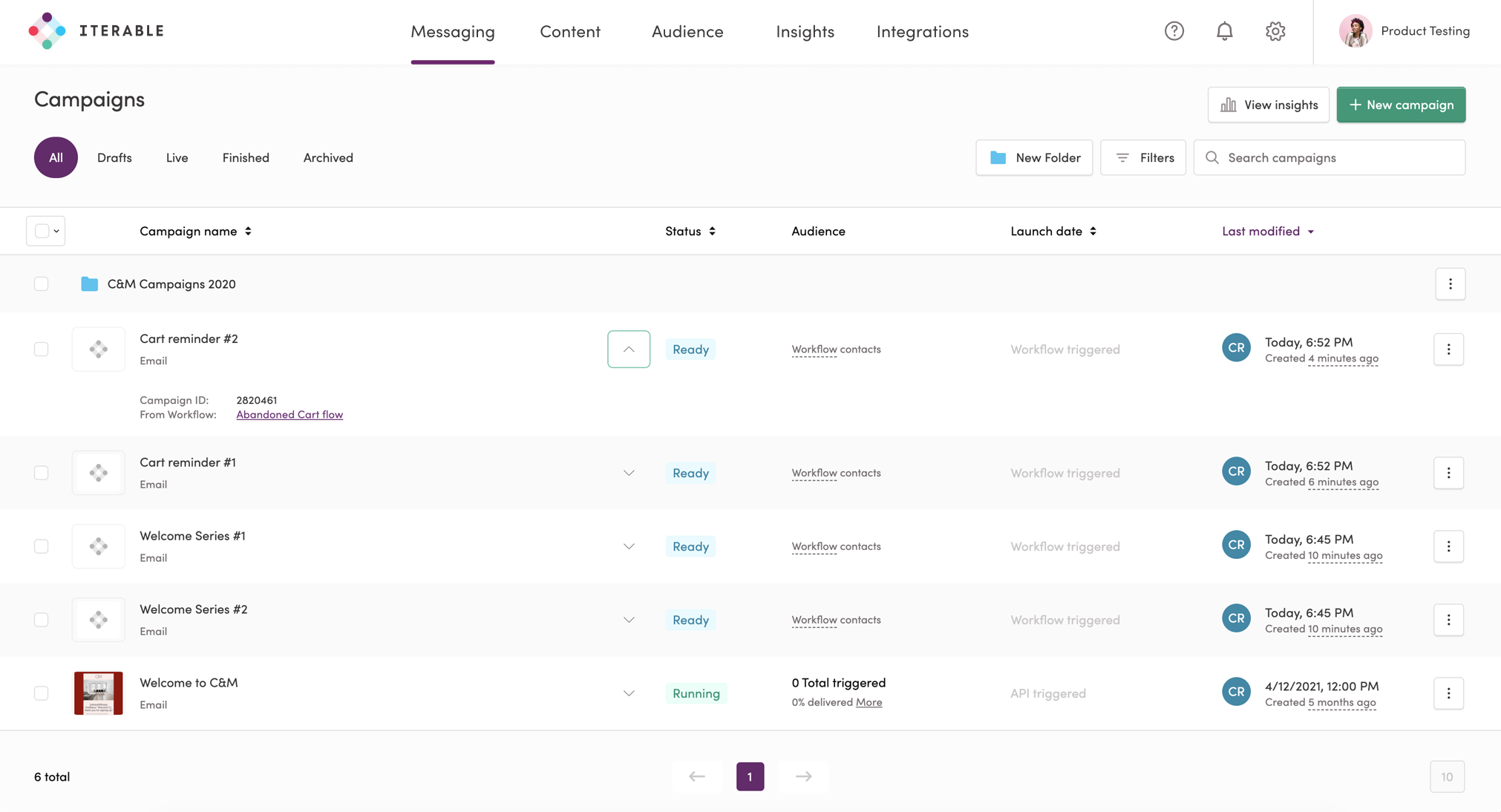
Iterable is the tool you get when marketing and data teams finally decide to play nice. It’s not the easiest platform to start with, but once you wire it into your stack, it’s a powerhouse. A friend at a mid-stage SaaS startup told me they picked Iterable after burning out on half-baked integrations. Iterable acts like the central nervous system for customer data and engagement. It combines a customer data platform (CDP) with cross-channel automation, so your campaigns can pull directly from live user events and behavioral triggers.
Pros
- Unified CDP and cross-channel automation in one platform
- Deep personalization using behavioral and event-based data
- Strong API and data integrations for complex stacks
- Real-time analytics with cohort tracking and A/B testing
- Excellent for large-scale, multi-touch campaigns
Cons
- Expensive for smaller teams
- Requires setup time and technical integration
How Iterable Compares to WebEngage
WebEngage runs engagement campaigns. Iterable runs engagement ecosystems. It’s designed for teams that want to treat every interaction, like email, push, SMS, or in-app, as part of one connected user journey. If you’ve hit the limits of your automation tools and need full control over customer data and messaging, Iterable is the endgame.
Pricing: Custom quote based on data volume and feature needs.
User Rating: 4.4 (G2)
How I Chose These WebEngage Alternatives
I didn’t want another list filled with tools that look good in demos but break under real-world workflows. The goal was simply to find platforms that fix the actual problems teams face once WebEngage starts showing limits: targeting precision, design control, and integration depth.
Every tool here was either tested hands-on or vetted through direct conversations with teams using it in production. The selection came down to five questions, the same ones I’d ask before adding any platform to my own stack.
- Functional Breadth: Can it manage engagement, feedback, and automation together, or does it need plug-ins and workarounds?
- Ease of Setup: How quickly can a team launch campaigns without calling in developers or sitting through onboarding webinars?
- Targeting Accuracy: Does it allow precise page-level and behavior-based triggers — the kind that WebEngage often struggles to execute?
- Integration Quality: Does it sync cleanly with CRMs, analytics tools, and customer databases without breaking connections every few weeks?
- Scalability and Support: Can it keep up when user volume doubles or new communication channels get added to the mix?
This isn’t a popularity ranking. It’s a list built around what actually drives operational value to reduce friction, improve accuracy, and scale with you instead of slowing you down.
FREE. All Features. FOREVER!
Try our Forever FREE account with all premium features!
WebEngage Alternatives: My Top 3 Picks
After testing, comparing, and speaking with teams that use these tools every day, a few clear winners stood out. Each one represents a different kind of strength, from simplicity to scale.
1. Qualaroo
The strongest choice for teams focused on understanding the why behind user behavior. Qualaroo’s contextual “Nudges” capture feedback while users are still interacting with your product, making the insights more accurate and actionable. It’s the ideal option for product, UX, and growth teams that need in-the-moment user intelligence rather than delayed survey data. With behavior-based targeting, sentiment analysis, and an easy setup process, it delivers fast, meaningful feedback without overcomplicating your stack.
2. Insider
The strongest choice for teams operating at scale or managing multiple engagement channels. Its predictive AI identifies user intent and automates campaigns before the user even acts, creating a seamless customer journey across web, app, and messaging platforms. It’s a data-driven system that rewards teams ready to think beyond rule-based automation and focus on personalized, high-impact engagement.
3. CleverTap
The best option for app-first businesses where timing defines success. CleverTap’s real-time streaming engine processes user actions instantly, allowing you to trigger campaigns in the exact moment that matters. It’s purpose-built for mobile engagement, combining deep analytics with fast, responsive automation that helps teams convert activity into retention at scale.
Choose the WebEngage Alternative That Grows With You
Most teams don’t switch from WebEngage because it fails. They switch because they’ve outgrown what it was built to handle. The further you scale, the more those early compromises, clunky targeting, rigid designs, and limited integrations start costing you time, conversions, and momentum.
The best WebEngage alternatives don’t reinvent your marketing. They refine it. They replace fragmented workflows with connected ones, automate intelligently instead of reactively, and give you the flexibility to match every campaign to your brand’s rhythm.
If your goal is to consolidate your feedback and engagement stack into a single, reliable system, an in-context survey maker is the ideal starting point. Whatever you choose, make sure it scales with your ambition, not against it. Your engagement stack shouldn’t just support your growth. It should accelerate it.
Frequently Asked Questions
How does customer support quality vary across these tools?
Support consistency is a major differentiator. Insider leads the pack with highly responsive, dedicated support teams. MoEngage, while generally strong, has mixed reviews for delayed issue resolution. When evaluating alternatives, always look at qualitative feedback — not just star ratings — because poor support can cost more time than pricing differences.
Which platforms are best for global or multi-region operations?
Insider and Netcore Cloud are both built for international scale. Insider’s global footprint includes strong review volumes in the Middle East and Asia, while Netcore’s infrastructure is optimized for APAC compliance and localization. If you operate across time zones or regulatory environments, these two handle regional complexity best.
What’s the main trade-off between enterprise and startup-friendly tools?
Enterprise platforms like Braze and Iterable offer extensive orchestration and data control but come with setup time, higher costs, and complexity. Startup-focused tools like Brevo and OneSignal trade some depth for accessibility and speed. The real decision depends on whether you value scalability or simplicity more right now.
How should design and branding factor into the decision?
Underestimating branding control is a common mistake. Many engagement tools output generic popups and surveys that feel detached from your brand. Qualaroo and Omnisend stand out here, letting you match fonts, colors, and layouts exactly to your product experience — a subtle detail that makes engagement feel natural rather than intrusive.
FREE. All Features. FOREVER!
Try our Forever FREE account with all premium features!

 We'd love your feedback!
We'd love your feedback! Thanks for your feedback!
Thanks for your feedback!


